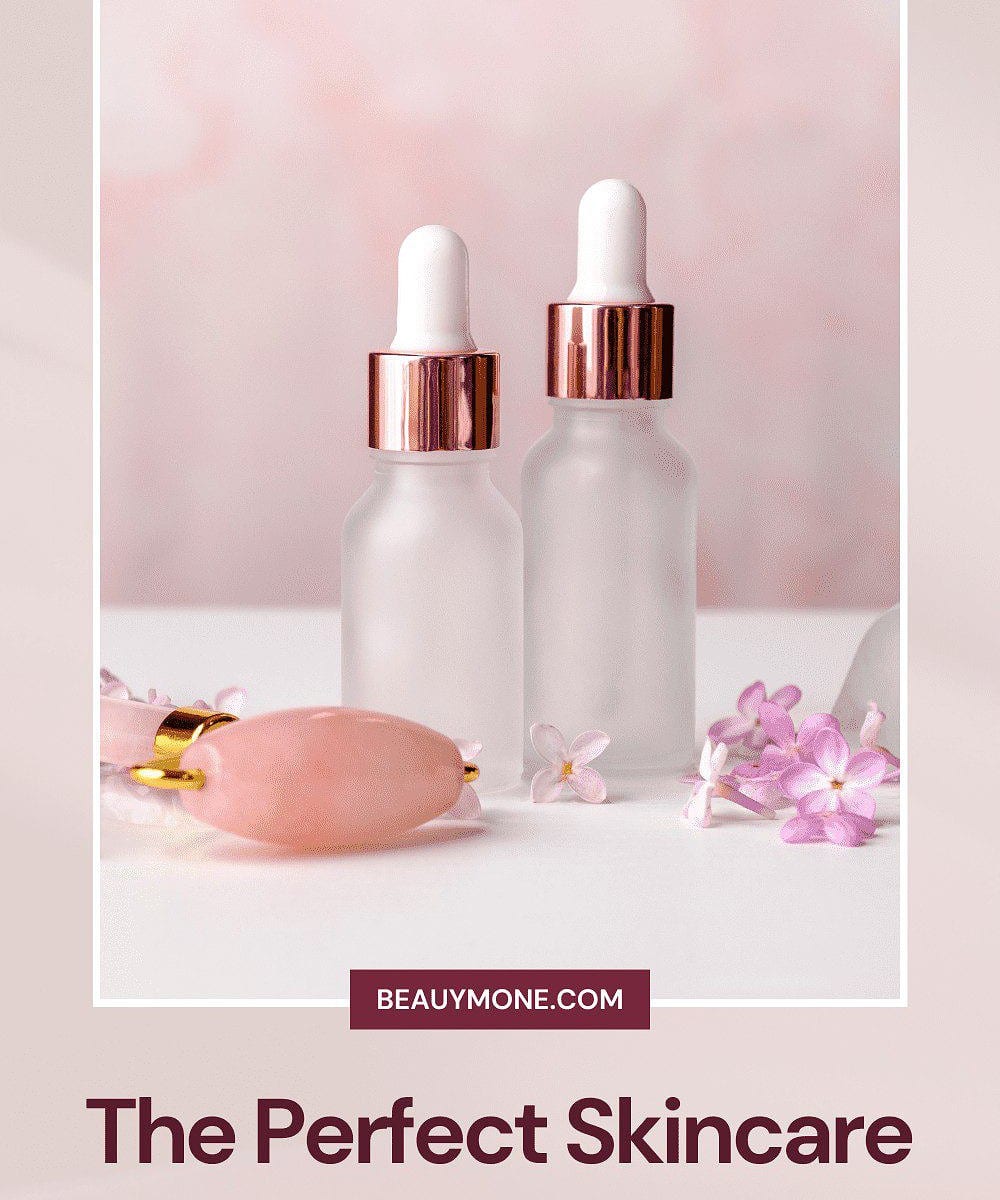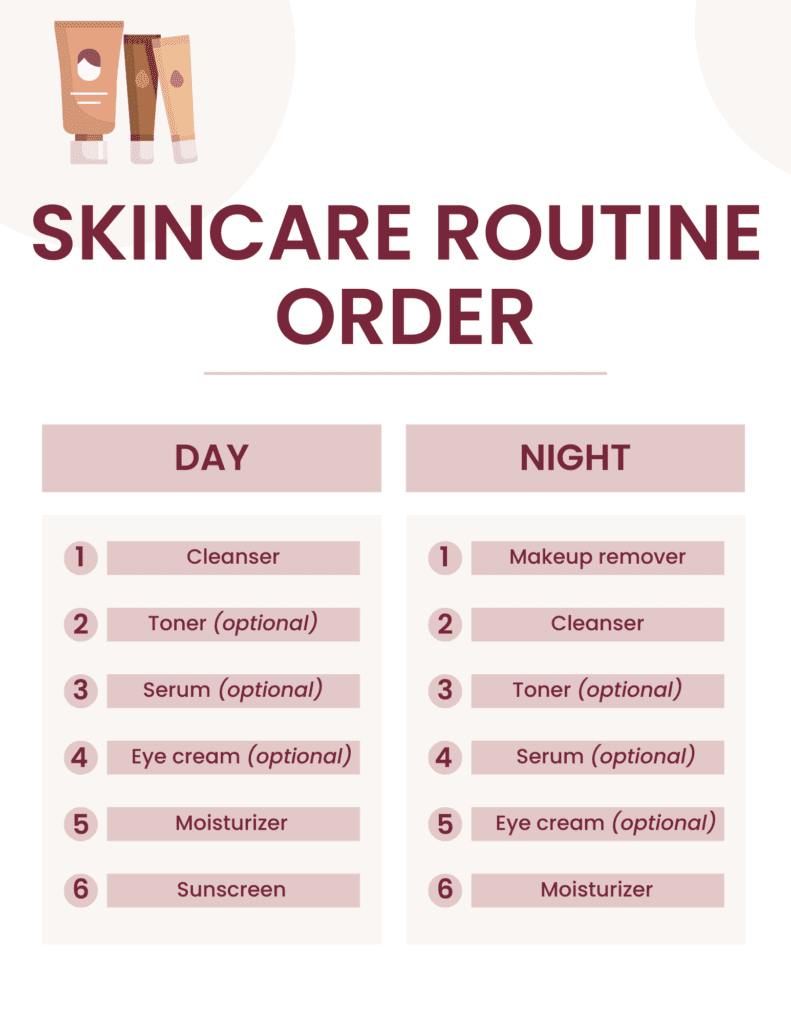
Taking care of our skin is important, and having a consistent skincare routine is one of the best ways to maintain healthy, glowing skin.
Whether you’re a skincare newbie or a seasoned pro, it can be difficult to know where to start with your skincare routine, especially when it comes to figuring out the order in which to apply your products.
In this post, we’ll guide you through the recommended skincare routine order for both morning and night, so you can start taking care of your skin like a pro.
Skincare Routine Order For Morning and Night
The order in which you apply your skincare products is important because it affects how your skin absorbs them. Applying products in the wrong order can actually make them less effective and may even cause irritation or breakouts.
Generally speaking, you should apply your products in order of consistency, from lightest to heaviest. This allows your skin to absorb each product fully and ensures that they work together to achieve optimal results.
In the morning, your skincare routine should focus on protecting your skin from the sun, pollution, and other environmental factors that can damage it throughout the day.
At night, your routine should focus on repairing and nourishing your skin while you sleep. With that in mind, let’s take a closer look at the recommended skincare routine order for both morning and night.
Morning Skincare Routine Order
- Cleansing: Start your morning skincare routine by cleansing your skin to remove any dirt, oil, or makeup that may have accumulated overnight. Choose a gentle cleanser that won’t strip your skin of its natural oils.
- Toning: After cleansing, apply a toner to help balance your skin’s pH and prepare it for the rest of your skincare products. Look for a toner that contains ingredients like glycolic acid or salicylic acid to gently exfoliate and brighten your skin.
- Applying Serum: Next, apply any serums you may be using to target specific skin concerns, such as dark spots or fine lines. Serums are typically lightweight and contain high concentrations of active ingredients.
- Applying Eye Cream: Your eye area is delicate and requires special attention. Use a small amount of eye cream to hydrate and nourish this area and help reduce the appearance of puffiness and dark circles.
- Applying Moisturizer: After applying your serums and eye cream, it’s time to moisturize your skin. Choose a moisturizer that is appropriate for your skin type and contains SPF to protect your skin from the sun’s harmful rays.
- Applying Sunscreen: Finally, apply a broad-spectrum sunscreen with at least SPF 30 to protect your skin from UV rays, which can cause premature aging, sunburns, and even skin cancer. Apply sunscreen 15 minutes before sun exposure, and reapply every two hours if you’ll be spending time outside.
I’ve personally found that sticking to this morning’s skincare routine order has helped me maintain healthy and glowing skin throughout the day. It’s important to note that everyone’s skin is unique, so you may need to adjust this routine to fit your specific needs.
For example, if you have oily skin, you may choose to skip moisturizer and only use sunscreen. On the other hand, if you have dry skin, you may want to use a heavier moisturizer and skip the toner. Experiment and find what works best for you.
Night Skincare Routine Order
At night, your skincare routine should focus on repairing and nourishing your skin while you sleep. Here’s the recommended skincare routine order for your nighttime routine:
- Cleansing: Start your nighttime skincare routine by thoroughly cleansing your skin to remove any dirt, oil, or makeup that may have accumulated throughout the day. Double cleansing is a great option if you wear makeup or sunscreen, as it ensures that all impurities are removed from your skin.
- Exfoliating: Exfoliating is an important step in your nighttime skincare routine as it helps to remove dead skin cells and promotes cell turnover. You can use either a physical exfoliant, such as a scrub, or a chemical exfoliant, such as an alpha-hydroxy acid (AHA) or beta-hydroxy acid (BHA) toner.
- Applying Serums and Treatments: Just like in your morning routine, you should apply any serums or treatments you may be using to target specific skin concerns, such as acne or hyperpigmentation. These products typically contain high concentrations of active ingredients and work to repair and nourish your skin while you sleep.
- Applying Eye Cream: Don’t forget to give your eye area some love at night too. Use a small amount of eye cream to hydrate and nourish this area while you sleep.
- Moisturizing: After applying your serums and eye cream, it’s time to moisturize your skin. Choose a moisturizer that is appropriate for your skin type and contains nourishing ingredients like hyaluronic acid or ceramides.
- Applying Face Oils If you’re using a face oil, apply it after your moisturizer to help lock in moisture and provide additional nourishment to your skin. Face oils can also help to regulate oil production and soothe inflammation.
- Applying Spot Treatment: If you’re dealing with acne or other skin concerns, now is the time to apply any spot treatments you may be using. These products are typically applied to specific areas of your face to target and treat the issue.
By following this nighttime skincare routine order, you’ll be able to give your skin the nourishment and repair it needs while you sleep, so you can wake up with healthy and glowing skin.
Of course, just like in your morning routine, it’s important to adjust this routine to fit your specific skin concerns and needs.
Targeted Treatments
In addition to the basic steps of a skincare routine, you may want to include targeted treatments to address specific skin concerns. Here are some examples of targeted treatments:
- Spot Treatments for Acne: If you’re dealing with acne, spot treatments can be a great addition to your skincare routine. Look for products containing benzoyl peroxide, salicylic acid, or tea tree oil to target breakouts and prevent new ones from forming.
- Anti-Aging Treatments for Wrinkles and Fine Lines: If you’re concerned about signs of aging like wrinkles and fine lines, look for products that contain retinoids, which have been proven to reduce the appearance of wrinkles and fine lines over time. Read more about an optimized skincare routine for anti-aging here.
Adding targeted treatments to your skincare routine can help you achieve your specific skincare goals. Just be sure to introduce them slowly and one at a time to avoid overwhelming your skin. Targeted treatments should be applied after cleansing and toning, but before moisturizing.
Customizing Your Skincare Routine Based On Skin Type
Everyone’s skin is unique, which means that your skincare routine should be customized to fit your individual needs. Here are some basic guidelines for customizing your skincare routine based on your skin type:
- Skincare Routine for Dry Skin: If you have dry skin, focus on hydrating and nourishing your skin with products that contain ingredients like hyaluronic acid and ceramides. Use a gentle cleanser, and avoid over-exfoliating, which can further dry out your skin.
- Skincare Routine for Oily Skin: If you have oily skin, look for products that help to regulate oil production, like a toner containing witch hazel or an oil-free moisturizer. Use a gentle, non-comedogenic cleanser to avoid clogging your pores.
- Skincare Routine for Combination Skin: If you have combination skin, focus on using products that are gentle and balance your skin’s needs. Use a gentle cleanser, and consider using different products on different areas of your face if needed.
- Skincare Routine for Sensitive Skin: If you have sensitive skin, focus on using gentle, fragrance-free products that won’t irritate your skin. Use a gentle, non-foaming cleanser, and avoid using hot water, which can further irritate your skin.
By customizing your skincare routine based on your skin type, you can ensure that you’re using the right products for your skin’s needs, which can help to improve the overall health and appearance of your skin.
Consistency Is Key
No matter what your skincare routine looks like, consistency is key. Consistently using the same products and following the same steps, every day can help to improve the overall health and appearance of your skin.
Here are some tips to help you stick to your skincare routine:
- Make it a habit: Incorporate your skincare routine into your daily routine, such as doing it right after brushing your teeth in the morning and evening.
- Keep it simple: Don’t overwhelm yourself with too many steps or products. Start with a simple routine and gradually add in additional steps or products as needed.
- Find products that you love: Enjoying the products you’re using can make the experience more enjoyable and encourage you to stick to your routine.
Conclusion On Skincare Routine Order Morning And Night
In conclusion, having a consistent skincare routine that is customized to your skin’s needs is essential for maintaining healthy and glowing skin.
By following a basic skincare routine order, including targeted treatments, customizing your routine based on your skin type, and being consistent, you can achieve your skincare goals and improve the overall health and appearance of your skin. Remember, everyone’s skin is unique
Frequently Asked Questions

